
The Stables is the quietest place I have ever been. You can hear a twig drop in the woods, and a horse eating a buttercup. In between, complete, breathtaking stillness. Situated high on the southwest side of Orcas Island, this 25-acre ranch and creative compound hosts workshops in a variety of arts and crafts taught by the resident artists and invited guests. The simultaneous sense of vista and retreat makes for a very special place for art and reflection.
This July I signed on with my sister, Cassandra, and 17-yearold niece Zoë for a three-day workshop in cyanotype. My sister and I had spent early years growing up on a ranch, and to be together quite literally in a stables, sleeping in a loft above, sent us both into states of unexpected recollection. Every morning we looked out on two chestnut horses and followed their graceful ambulations across the pasture. The tooled leather and haymow, the 4-H, the riding rink, the coyotes under the moon and the back forty of our pasts tumbled into the present everywhere we turned. My niece, not yet of an age for elegies, lovely in pigtails and grave and hilarious by turns, focused on her senior year project in all things photographic. She proceeded to make one artlessly perfect composition after another. Note to self: make no helpful design suggestions when a true artistic gift is at hand.
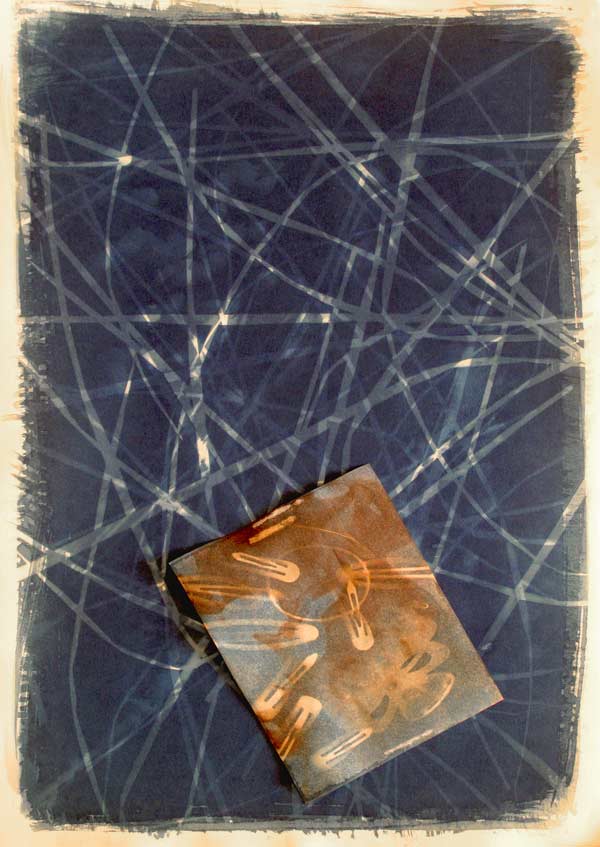
I had planned originally to work with my existing themes of architectural photography, and had spent days making negatives. At the last minute I threw two birdcages in the car. This turned out to be a very good idea. Within hours on the first day I could see that this process of cyanotype is an alive thing, a way to paint with the sun and your surroundings, an opportunity to toss out your preconceptions and open the door to the unexpected. Noted Seattle artist and cyanotype expert David Simpson taught us, and nudged and pushed us through three days of testing our limits. Although he had encouraged us to bring objects we also used what we found on site: crumpled wire, thistles, chainsaws, daisies, ferns. We laid these things on glass or directly on coated paper. Our fourth workshop member, printmaker Lynda Swenson, experimented with printing on maps and existing etchings and woodcuts.
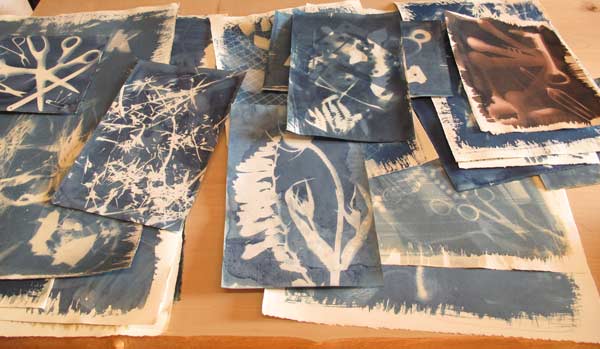
Upper right brown and black print shows how fabulously the Artistico works with tannic acid toning. Below, a composition with three dimensional blocks and pearls, testing cropping. The actual print is not this yellow. The photo was taken with warm light from the walls of the stables reflecting onto the surface. I would love a skirt with this printed on it!

In the first step we coated our paper with solution in a darkened stable under a red safe-light. When ready we dashed from the darkroom to the outside laboratory where we slid the paper under existing arrangements or began lightning fast compositions, lifting or placing objects for different effects. We all had various timing devices, and at times it looked like a circus casino, or perhaps a camp for people with attention deficit disorder. We rushed in and out of the barn, lifted and placed objects, stared at our paper variously counting outloud, watching a cellphone or a wristwatch, or drifting into conversation — “What minute was I on???” And then (this was the best part) we threw the paper into a kiddie wading pool to fix and finish developing.
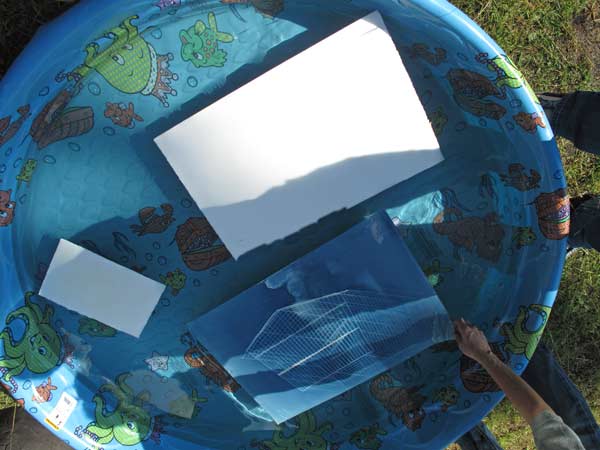
Some things I learned:
- Paper: Although many sites recommend Stonehenge as an ideal paper I would like to sell you a bridge to nowhere. I have fifty sheets of this stuff and we universally loathed it. No depth. A pale obnoxious blue. Also no watermark and cheap—what was I thinking??
- Rives BFK takes on odd shades of brown under some circumstances, which sometimes adds a pleasing element. The cyanotype solution tends to bead up and it is very hard to know if you have the edges of your paper covered in the semi dark.
- 400 pound Strathmore rag bristol mottles. It also can delaminate in the bath. But, you can then recoat the separated sheets and use the mottled tints as background to create lovely new images. Some of my sister’s best pieces were created this way. They have a wonderful vintage quality and tonal depth.
- Fabriano Artistico hotpress provides phenomenal fine grained exposures and takes toning elegantly, you can created a black and brown duotone with crisp luminous whites. I wish I had bought fifty sheets of THIS. Rives worked best with the few photo negatives I tried. I did test strips, and timing through clamped glass was one half to one third of that needed for objects (ie. For negatives, an average of four minutes in hot July sun.)
- Water: The Orcas water comes from a well and has minerals in it. This may be why certain prints took an amber cast after several coatings. Cyanotype is the art of variables. Washing and fixing prints in city water with chlorine could lead to completely different results. I had mysterious perfectly round spots on my first three or four prints, which appeared only after the water bath. It took a lot of detective work, but we finally figured out that it was bubbles formed by not immersing the paper fast enough and completely enough—and do immerse the paper face down.
- Adding peroxide to the water bath: you get blazing blues. We didn’t test definitively enough to know if the blues lasted and were as dark or darker than cured prints, but we decided it might be kind of a cheap trick.
- Time: Make no final decision on anything until prints have dried and oxidized for at least 24 hours. They can darken drastically.
- Random magic: Yes, you can expose while paper is still wet, and it leads to beautiful effects like watercolor. You can also paint with solution under the sun. The solution will change and change as you paint, losing potency as it is exposed. There is absolutely no need to take a meditation workshop or study impermanence with a master from the East. Just pour cyanotype onto paper under the sun and spend some days watching it dry. Change is the only constant.
Above, a piece in progress. I painted under bright sun, adding new solution. As it dried it turned strange shades of rust and pink and two new shades of blue I hadn’t seen before. Then it all disappeared in the wading pool and became something else.
One of the most promising experiments I did involved folding paper while it was wet. I do wish I had figured out the cause of the mysterious round spots before I did “Origami Cage”, but I am including it here because I think it’s interesting. I can’t tell you how great it felt to completely beat up a piece of paper. When I wake up in the morning one of the first things I see when the sun is out is the shadow of birdcages cast onto the wall. I have tried off and on for ten years to capture them in some way. I think they finally found their home.
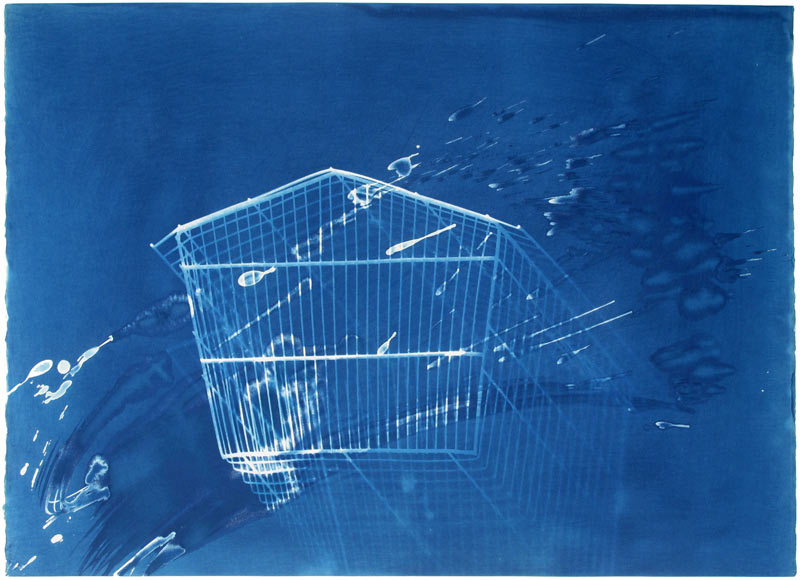

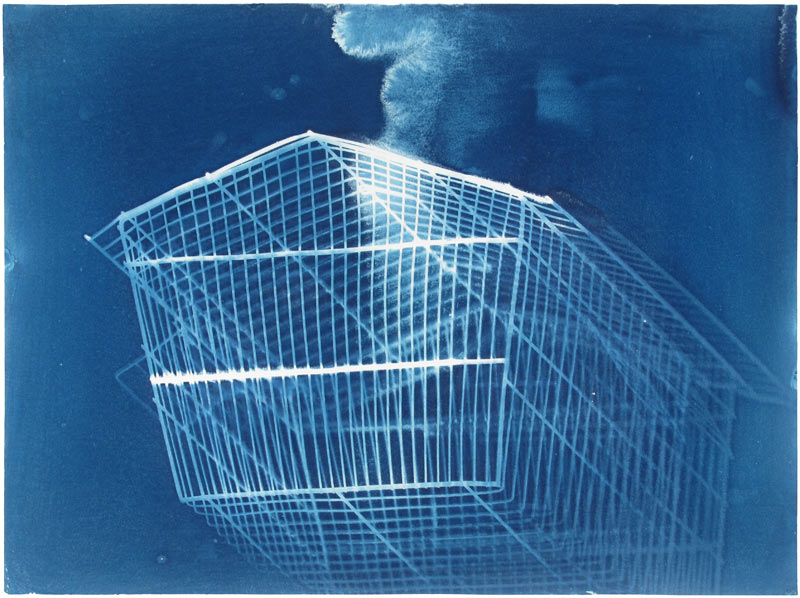

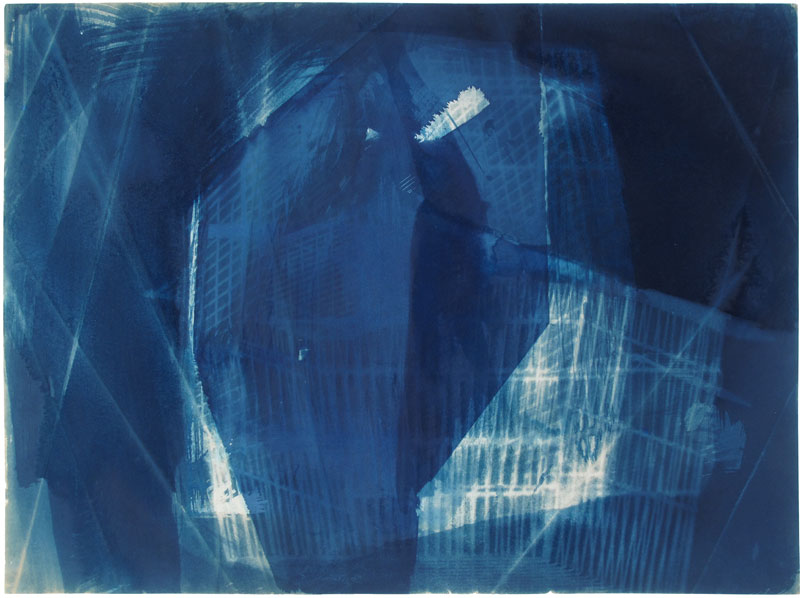
And, a couple of links. You can find out everything you ever want to know about cyanotype and alternative processes at Alternative Photography.com. And don’t miss David Simpson’s work at Photographic Wanderings at Lisa Harris Gallery opening August 2.

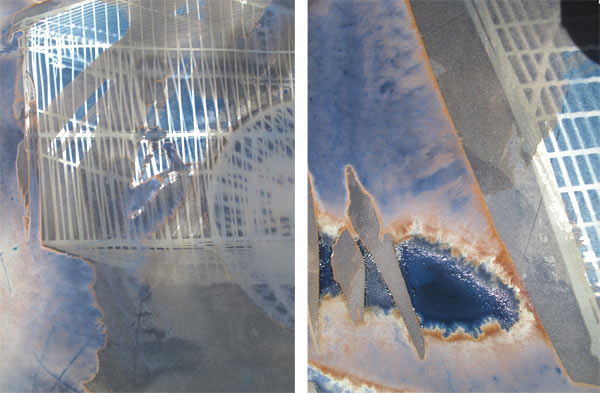
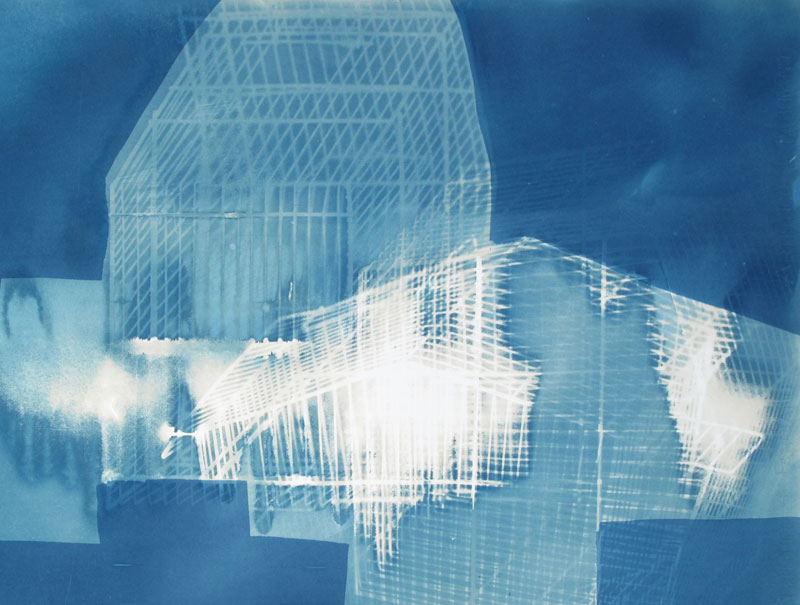
Kate says
Iskra, the vibrant blue prints at the end are magical! It’s as if the cage itself were submerged under water. Such watery, still prints seem befitting products of your time in such a still, water-surrounded place. Neat too that you choose to share your technical gleanings.
I was intrigued by Lynda Swenson’s idea of printing on surfaces that already have images: seems like there’s a lot of possibility there! It makes me wonder what would happen if you could print some of your computer-based work in a non-water-soluble ink, and then submerge it into the cyanotype depths. Lovely!
Iskra says
Thanks Kate! An interesting idea, the digital hybrid. This is one of those media where a digital scan just doesn’t do justice. The originals have all kinds of subtle green pulses, and scale, well, everything is the same size on the computer, just press plus or minus, the Space Needle or a spool of thread who can tell the difference without a sparrow in the picture. I am so grateful for the information out there on alternative photography sites (minus the Stonehenge recommendation:)) I thought I’d add my two cents.
Jana Schwartz says
These are truly beautiful and unique! And yes, you can have the blocks and pearls on a fabric if you like, just let me know. I really like the bird cage with the bubbles; it makes me think of a bird that freed itself and swam away; like the flying I do in dreams where it feels like swimming. These images are all very dream like.
Obadinah says
These images are such enchanting and mysterious metaphors for transient states. Thanks for sharing them. The technical information was interesting too.
Leslie Newman says
Wonderful post Iskra, thanks for sharing so much of the experience and techniques. Makes me wish I was there.
Diane Tchakirides says
Iskra, you are a good writer AND a good artist. Geez. Too much talent! I enjoyed your report from Orcas.
diane
Nancy Current says
Thanks for the wonderful blog about this class. I really wanted to take it, but couldn’t, so I’m so happy to read your advice and see the results. You’ve done some interesting work, and I hope I’ll see more of it. Hopefully I’ll get to try out this technique soon. Your blog provides a lot of encouragement.